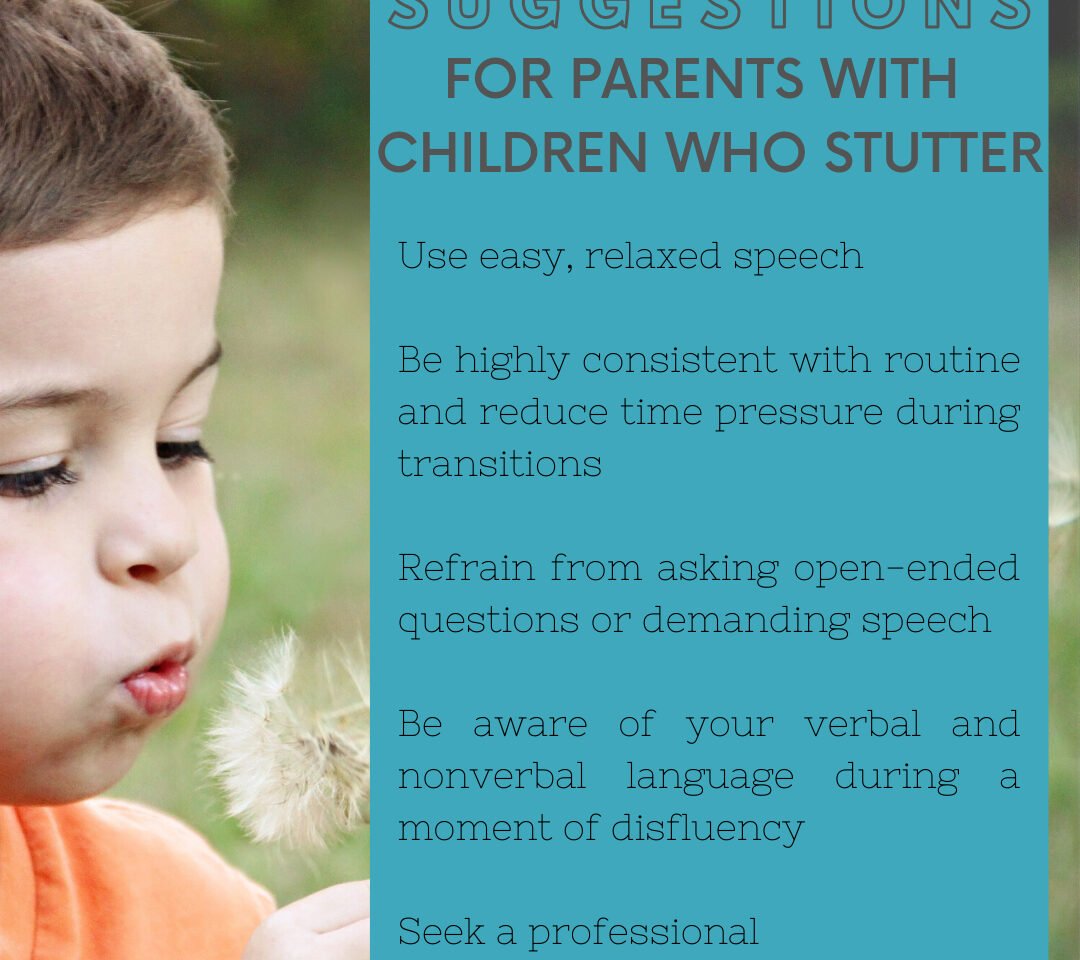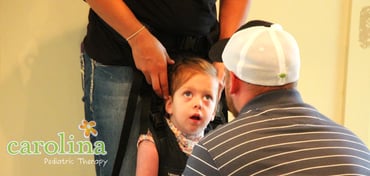Suggestions for Parents with Children Who Stutter
As preschoolers become increasingly verbal, they may stumble over their words. They are learning so much language during these primitive years and sometimes their speech motor systems simply cannot keep up. Despite it being common, disfluencies can still raise concerns about stuttering for parents. For most toddlers and preschoolers, most disfluencies go away on their own after some time. However, some disfluencies persist and the signs of stuttering become more severe and intervention is warranted. See the chart below for common risk factors that may indicate atypical disfluencies:Early treatment for stuttering is important, as it is more likely to be eliminated when a child is young. The following are strategies caregivers can try to modify their own communication styles and to reduce environmental demands on the child to help eliminate atypical disfluencies:
Use easy, relaxed speech. Always speak to a child who stutters in an unhurried, relaxed way, pausing frequently. This calms the child and takes away the pressure to keep up. It also models the way we want the child to speak. Some families find placing visual cues in the house can help to remind the adults to model the desirable speech, since it can be unnatural at first.
Be highly consistent with routine and expectations. We often see an increase in stuttering and stuttering behaviors when an unexpected situation occurs and the child must use new language. Try to stay as consistent as possible, especially during structured time, like getting ready in the morning and the bedtime routine at night.
Reduce time pressure during moments of transition. Transitions are often a tough time for caregivers. In the morning, caregivers must wake the kids up, get them dressed, eat breakfast, and get to daycare or school. This often places a time pressure on the children, which can result in increased stuttering. Being consistent with routine and expectations can help, but life often throws unexpected changes at us. Give advanced warnings for all transitions, such as telling the child “I am going to set a timer for 5 minutes. When you hear the alarm, we will clean up our toys and go find our shoes.” This will eliminate the need for rushing when it comes time to transition.
Refrain from asking open-ended questions and demanding speech as much as possible. When we ask a child an open-ended question, we open up that child to remember and recount every moment of their very busy days. This can create a demand for speech that can lead to stuttering. Instead, we can comment and allow the child to respond on their own time. For example, instead of asking a child “How was your day today?” we can instead comment “Your teacher told me you played outside today. It must have been fun.” This reduce the communication pressure and allows the child to respond as they wish.
Just like with a question, try to avoid telling the child to say a certain word or phrase. For example, if an adult does something for our child, more often than not, we respond with, “Tell them ‘thank you!’” This puts the child on the spot with an audience and specific words to be said, which can lead to stuttering. Instead, model the expected response.
Practice patience. Give your child time to finish their thought. Don’t rush or interrupt them. Phrases such as “slow down” or “think before you talk” brings attention to the disfluency. The child may get the notion that the listener does not approve when they stutter. Therefore, this type of reinforcement perpetuates the “trying not to stutter” and related tension. Instead, listen to the child and repeat or rephrase the stuttered phrase using easy, relaxed speech.
Maintain supportive non-verbal language. Remember that communication is about 90% nonverbal, and your facial expressions can say a million words! Children can interpret many facial expressions at a very young age. Model a relaxed, patient, and supportive expression when your child is speaking, especially during a moment of disfluency.
Make sure that all significant listeners are aware of and consistent with these strategies. This includes parents, teachers, babysitters, grandparents, siblings and others. Unfortunately, one person using punitive reinforcement can undermine the rest. Get everyone in your child’s circle of care on the same page to provide the most supportive environment for your child.
Consult a professional. If you are concerned with your child’s disfluencies and are noticing atypical disfluencies, contact a Speech-Language Pathologist to get a fluency evaluation completed. Getting intervention early offers the best chances for reducing stuttering in your little one.Information in this blog is supported through the articles and continuing education videos below:
Kristin Chmela, M.A. CCC-SLP, BRS-FD – Working with Preschoolers Who Stutter: Successful Intervention Strategies
Craig Coleman, M.A., CCC-SLP, BRS-FD – Stuttering in Toddlers & Preschoolers
Tim Mackesey CCC-SLP – How Parents Can Help a Child Who Stutters[ld_section_title title="Want to know how a Therapist can Help?" title_top_margin="10" title_bottom_margin="10" subtitle_top_margin="0" subtitle_bottom_margin="10" text_top_margin="0" text_bottom_margin="0"]Schedule your infant, child, and teen for an evaluation today and see how a therapist can help your family.
Call (828) 398 0043 or click on the schedule button.[/ld_section_title][ld_button style="btn-solid" title="Schedule Today" transformation="text-uppercase" shape="circle" color="rgb(13, 156, 252)" fs="12px" ls="0.15em" hover_color="rgb(255, 255, 255)" htext_color="rgb(13, 156, 252)" link="url:https%3A%2F%2Fcarolinapeds.com%2Fscheduling%2F|||"]
Want to know how a Therapist can Help?
Call (828) 398 0043 or click on the schedule button.



